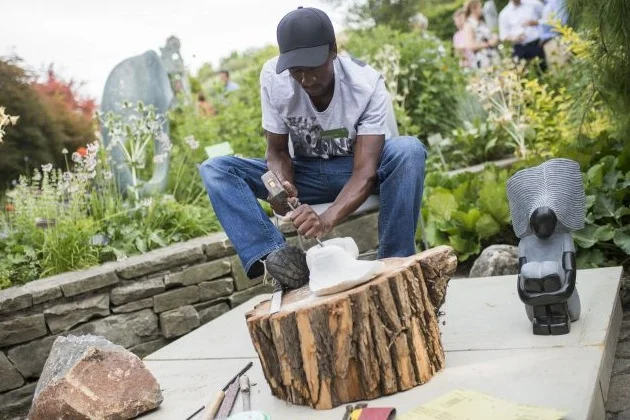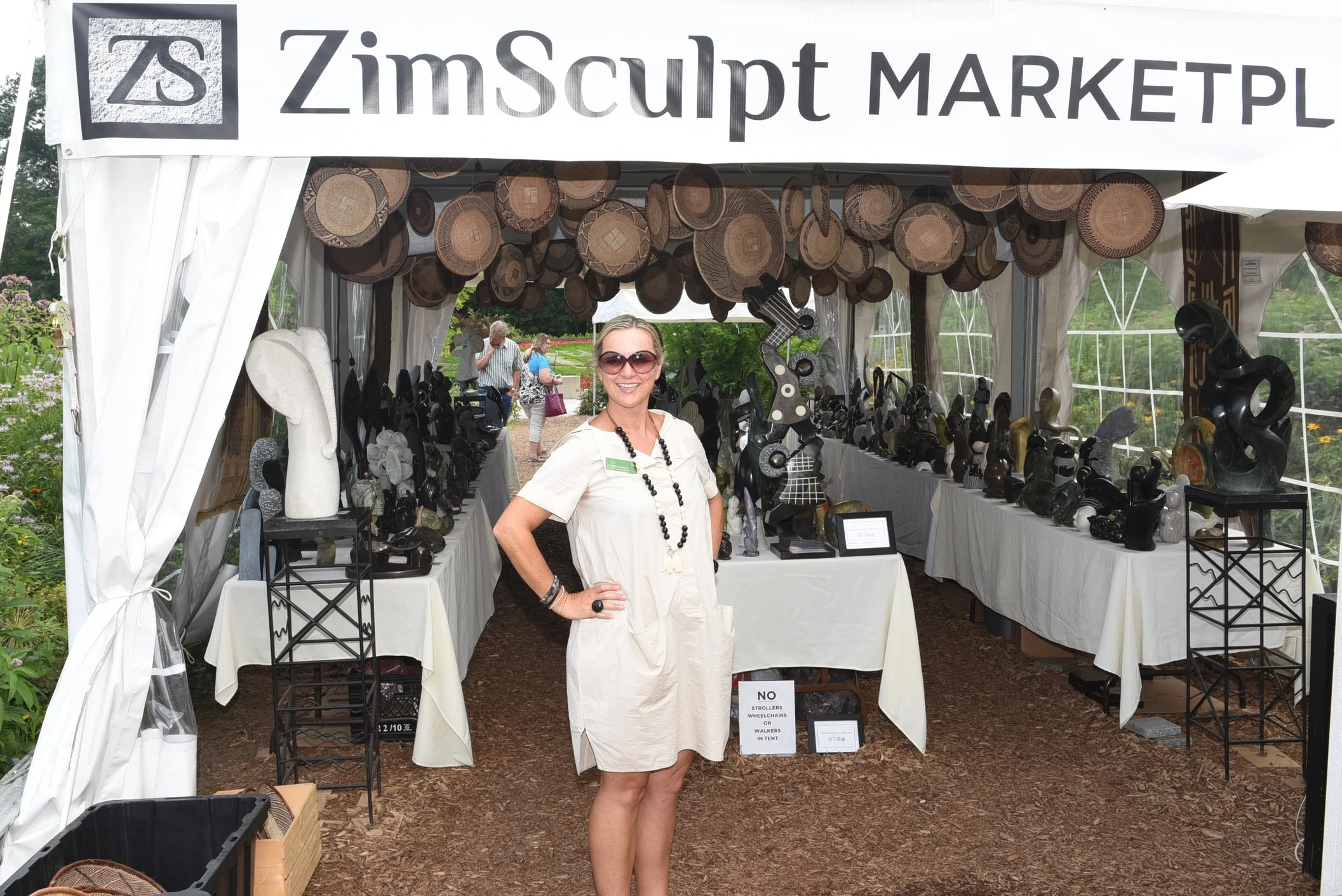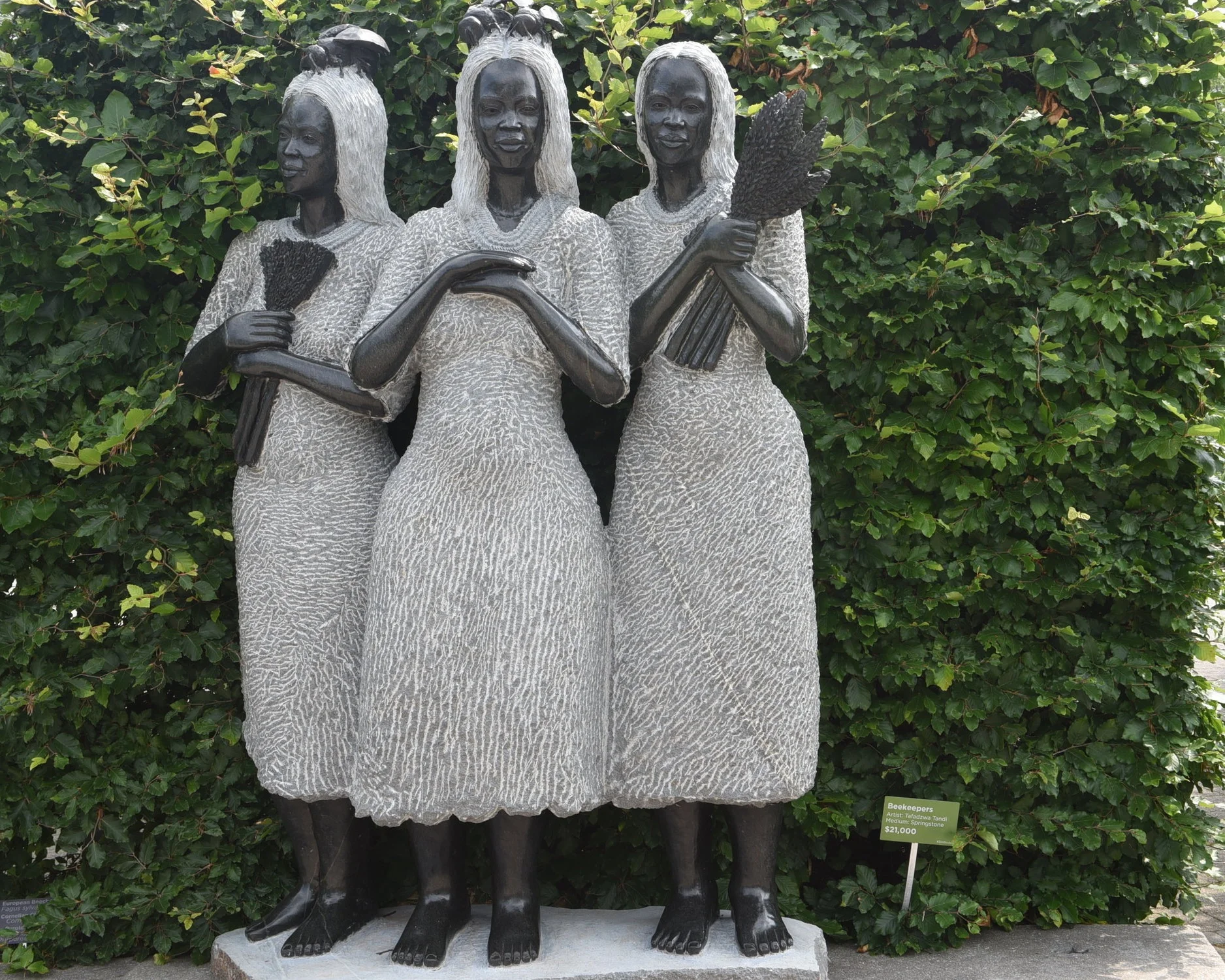Zimbabwe stone sculpture on display in Toronto
August 31, 2019
Busy stone sculpting a bird on a sweltering mid-summer afternoon, Passmore Mupindiko raises his head and smilingly acknowledges another visitor to the Toronto Botanical Gardens.
He’s one of two artists-in-residence this year at ZimSculpt’s 10-week exhibition showcasing hundreds of hand-made Zimbabwean stone sculptures.
Established in 2000, ZimScuplt stages exhibitions around the world to promote the work of the landlocked southern African country sculptors.
Travelling with them for the past 12 years, this is the second time that Mupindiko is in Toronto.
Passmore Mupindiko
“I love this city,” he said. “The people are so open, warm and very generous.”
The first of five children born in 1975, Mupindiko dropped out school just before his final exams to take care of his family after his father’s death. To earn an income, he turned to wood carving.
“My grandfather was a wood carver and I picked up woodworking from him before turning to stone,” he said. “This is passed on from generation to generation.”
Often working with Opal Sone and Spring Stone, his elegant renderings of the Guinea Fowl stands out and his work has been exhibited around the world.
The other artist-in residence is Brighton Layson who left Zimbabwe for the first time last year to attend the Toronto Botanical Gardens exhibition.
Brighton Layson
“It is important that they are here because everything is done with hand tools and they can show visitors how the pieces are created,” said ZimSculpt founder Vivienne Croisette. “They also both speak English which is important because they have to communicate with clients and visitors. We brought stone from Zimbabwe which they sculpt and then sell. They get to keep the proceeds from those sales while ZimSculpt takes care of their travel expenses and accommodation. The artists are an integral part of our show and are invited to also represent their fellow artists back home.”
With unemployment hovering around 80 per cent and with raw materials to sculpt easily available, most Zimbabweans dabble in sculpting.
“Many of them find the form of their inspiration in the shape of the rock and they each have their own personal style and will choose the stone to suit their style,” said Croisette. “Everything is created free-form and there’s generally no pre-sketching.”
Vivienne Croisette
The artists work with hand tools comprising hammers, chisels, points and rasps.
“These tools provide many different effects,” she said. “The finishing of a sculpture takes just as long as the actual creation and the smooth effect is achieved by using wet and dry sandpapers. If an artist is looking for a high polish on the stone that gives a dramatic difference in the colour and texture, the stone is heated and that process expands the pores and a natural floor wax is applied to the designated area. This is left to soak into the stone until cooled and then buffed up to a high gleam which finishes the work.”
A curator in England for British artists for about seven years, Croisette accepted an invitation 19 years ago to visit Zimbabwe and have a look at traditional stone sculptures created by some of the country’s finest artists.
“Many people were leaving the country as I was going in because of the economic and political upheaval at the time,” she recalled. “I took some of their work back to England to promote at garden and trade shows where they were well received.”
With no formal art training, Croisette met a sculptor when she was 19 and started to promote his work in South America.
“I met a lot of artists in that part of the world, started to promote their work and organized exhibitions without realizing it was a job,” she said. “I really engaged with the artistic environment and did shows that were very successful. On my return to England, I promoted South American artists and then got to know and promote British artists before someone from Zimbabwe came to one of the shows and asked if I would like to work with Zimbabwean artists. I accepted.”
Impressed with stone sculptures he bought online from ZimSculpt, a Canadian of Algerian descent residing in Brampton invited Croisette to stage an exhibition in North America.
“I didn’t have any contacts in these parts then and he said he would do some checking around and get back to me,” she said. “I also let him know that I am used to doing garden shows as the sculpture lends itself perfectly to the outdoors.”
The Royal Botanical Gardens, the largest in Canada and a National Historic Site, was identified for ZimScuplt to make its North American debut.
“We were in Hamilton in 2006 and 2007 and again in 2012 and 2013 and our shows were successful,” said Croisette who is married to Frenchman Joseph Croisette who she met in Zimbabwe.
When Harry Jongerden joined the Toronto Botanical Gardens in 2013 as executive director after serving as Head of Horticulture and Garden Designer at the Royal Botanical Gardens and Garden Director at the Van Dusen Botanical Garden in Vancouver, he reached out to Croisette with an invitation to consider coming to Toronto.
Back for the second year at the 17 themed ‘city sized gardens’ at 777 Lawrence Ave. E. at Leslie St., the outdoor art exhibition showcases nearly 100 sculptures in the garden and 400 pieces in the marketplace.
“There’s something here for everyone,” said Croisette. “In the marketplace, we have small stone eggs made of semi-precious stone that go for as low as $9, earrings, necklaces, bangles, hair pins, combs, rings and binga baskets made of dried lala palm. There are about 100 figurative, abstract and animal sculptures in the garden crafted by Zimbabwean artists.”
The exhibition ends on September 22.
ZimSculpt’s next North American show will be in Huntsville, Alabama from April 3 to May 31 in 2020.
















